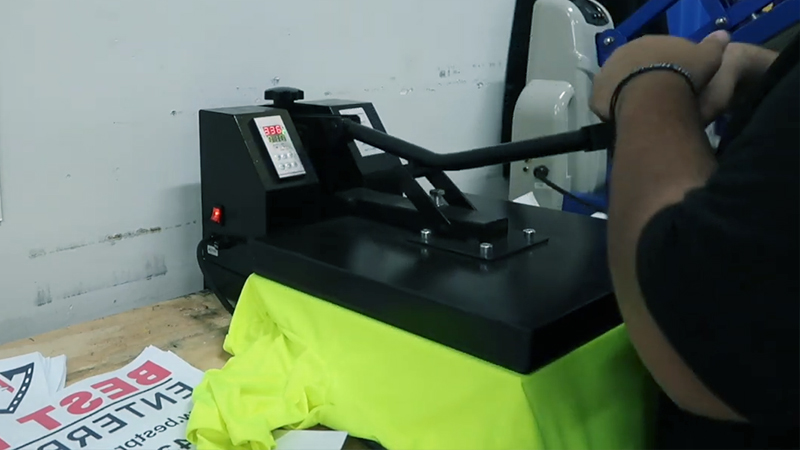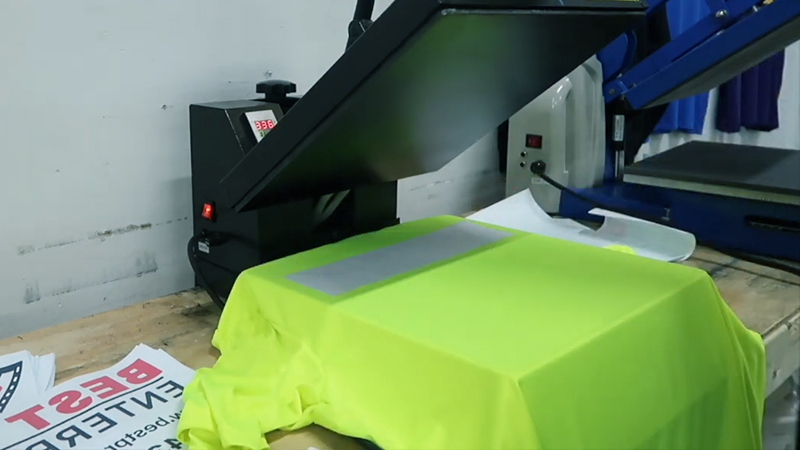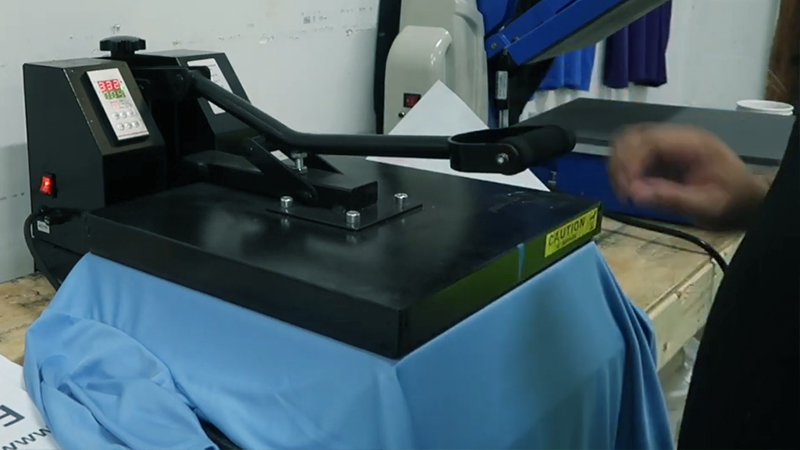The use of heat press machines has revolutionized the world of customization and printing on textiles, opening up a realm of creative possibilities.
However, when it comes to heat-pressing polyester, a fabric celebrated for its durability and versatility, there are certain considerations and precautions to keep in mind.
Polyester, being a synthetic fabric, can be sensitive to heat, making it crucial to understand the right techniques to ensure successful results without damaging the fabric.
In this guide, we delve into the question: “Can you heat press polyester?” and explore the temperature ranges and best practices for achieving vibrant and lasting prints, whether you’re working with sublimation, heat transfer vinyl (HTV), or other methods.
With the right approach, heat-pressing polyester becomes a versatile and effective way to create personalized garments and items.

Can You Heat Press Polyester?
Yes, you can heat-press polyester, but it requires a careful and controlled approach. Polyester is a synthetic fabric known for its durability and resistance to wrinkles, making it a popular choice in various applications, including sportswear, activewear, and sublimation printing.
When heat-pressing polyester, it’s crucial to adhere to specific guidelines to avoid damaging the fabric.
Polyester is sensitive to heat, and excessive temperatures can cause it to melt or scorch, resulting in irreversible damage.
To heat press polyester successfully, use a heat press machine with adjustable temperature and pressure settings. Set the temperature to a lower range, typically between 270°F and 300°F (130°C to 150°C), and ensure even heat distribution.
Place a Teflon or silicone sheet between the fabric and the heat plate to prevent direct contact and potential scorching. Apply moderate pressure and keep the pressing time relatively short, usually around 15-20 seconds, to minimize the risk of overheating.
Following these precautions, you can successfully heat-press polyester and achieve vibrant and lasting sublimation or transfer prints.
What Temperature Do You Heat Press Polyester?
The ideal temperature for heat-pressing polyester varies depending on the specific type of polyester fabric and the transfer or sublimation process you’re using.
Here are the temperature ranges for different polyester applications:
Sublimation Printing (Lightweight Polyester)
Temperature
380°F to 400°F (193°C to 204°C)
Description
Sublimation requires higher temperatures to turn the ink into a gas that bonds with the polyester fibers. Lighter-weight polyester fabrics, such as those used in sports jerseys, often require these elevated temperatures.
Sublimation Printing (Heavyweight Polyester)
Temperature
380°F to 400°F (193°C to 204°C)
Description
Heavier polyester fabrics, like those used in outdoor banners and flags, may also need the same higher temperature range for effective sublimation.
Heat Transfer Vinyl (HTV) on Polyester
Temperature
305°F to 320°F (152°C to 160°C)
Description
When applying heat transfer vinyl to polyester, a slightly lower temperature range is recommended. It’s essential to check the vinyl manufacturer’s instructions for precise temperature settings.
Dye-Sublimation to Polyester Blanks (Mugs, Phone Cases)
Temperature
Varies (typically around 400°F or 204°C)
Description
Dye-sublimation for non-fabric items, such as mugs or phone cases, may require a very high-temperature setting. Exact temperatures can vary based on the item and the sublimation paper used.
Inkjet Heat Transfer Paper on Polyester
Temperature
375°F to 400°F (190°C to 204°C)
Description
Inkjet heat transfer paper is often used to create custom designs on polyester fabrics. The high-temperature setting helps the ink adhere to the fabric effectively.
Heat Transfer Paper for Dark Polyester
Temperature
350°F to 375°F (177°C to 190°C)
Description
Heat transfer paper for dark-colored polyester garments requires a lower temperature setting to avoid scorching or damaging the fabric while achieving a vibrant transfer.
Dye-Sublimation on Polyester Garments
Temperature
380°F to 400°F (193°C to 204°C)
Description
When sublimating polyester clothing, similar to lightweight polyester, a high-temperature range is typically recommended to ensure the ink bonds with the fabric.
Always refer to the specific recommendations of your heat press machine, transfer materials, and the polyester fabric you’re working with. Testing on a scrap piece of fabric is a good practice to determine the optimal temperature for your specific project while avoiding any potential damage to your garments.
Do’s To Heat Press Polyester

Successfully heat-pressing polyester requires careful attention to detail to ensure the best results. Here are some essential “do’s” when heat-pressing polyester:
Check the Fabric’s Care Label
Always begin by checking the care label on your polyester garment. This label provides valuable information on recommended temperature settings and any specific care instructions for the fabric. Adhering to these guidelines helps prevent damage.
Use a Heat-Resistant Cover Sheet
Place a heat-resistant cover sheet, typically made of Teflon or silicone, between the polyester fabric and the heat plate of your heat press machine. This sheet protects the fabric from direct heat contact and potential scorching while ensuring even pressure distribution.
Preheat Your Heat Press
Preheat your heat press machine to the required temperature before placing the fabric. Preheating helps ensure even and consistent heat application, which is crucial for successful heat transfer or sublimation.
Choose the Right Transfer Material
Select the appropriate transfer material for your project. Whether you’re using heat transfer vinyl (HTV), dye-sublimation paper, or transfer paper, make sure it’s compatible with polyester. Consult the material’s instructions for temperature recommendations.
Maintain Even Pressure
Ensure that you apply even pressure across the entire heat press surface. Irregular pressure can result in uneven transfer or sublimation, leading to unsatisfactory results. Adjust your heat press machine as needed to maintain uniform pressure.
Observe Recommended Pressing Time
Adhere to the recommended pressing time for your specific transfer material and project. Timing is crucial for ensuring that the design or ink bonds effectively with the polyester fabric. Avoid under- or over-pressing, which can affect the quality of your results.
Cool Down and Handle with Care
After pressing, allow the garment to cool down before handling it. Polyester can be sensitive to heat, and immediate handling may cause distortion or damage.
Once the garment has cooled, handle it with care to avoid stretching or pulling the fabric.
Following these “do’s” when heat pressing polyester helps you achieve the best results while preserving the integrity of your garments.
Remember that each project may have unique requirements, so always consult the specific guidelines provided by your transfer material manufacturer and the care label of your polyester fabric.
Don’ts To Heat-Press Polyester

Avoiding common pitfalls when heat pressing polyester is essential to prevent damage and achieve successful results. Here are some “don’ts” to keep in mind when heat-pressing polyester:
Don’t Use Excessive Heat
Avoid setting the heat press at excessively high temperatures, as this can melt or scorch the polyester fabric. Overheating may lead to irreversible damage, such as color distortion, texture changes, or fabric shrinkage.
Don’t Overlook the Care Label
Never skip checking the care label of your polyester garment. Ignoring care instructions can lead to mishandling, as some polyester fabrics are more delicate than others. Adhering to the care label’s recommendations is crucial for avoiding damage.
Don’t Skip Preheating
Do not forget to preheat your heat press machine. Preheating ensures that the heat platen is at the correct temperature and helps to eliminate any excess moisture from the fabric, facilitating better adhesion of transfer materials.
Don’t Apply Uneven Pressure
Avoid uneven pressure during the heat-pressing process. Uneven pressure can lead to incomplete transfer or sublimation, resulting in irregular and unsatisfactory results. Ensure that your heat press maintains uniform pressure throughout the process.
Don’t Overheat Transfer Materials
Overheating transfer materials like heat transfer vinyl (HTV) can lead to poor adhesion and peeling.
Follow the specific temperature and time recommendations for the material you’re using, as excessive heat can affect the quality of the transfer.
Don’t Overpress or Underpress
Avoid pressing for too long or too short a duration. Overpressing may damage the fabric or overheat the transfer material, while underpressing can result in inadequate adhesion. Follow the recommended pressing times for your specific project.
Don’t Handle the Fabric While Hot
Do not touch the polyester fabric immediately after pressing. Polyester can be sensitive to heat, and handling it while hot can lead to fabric distortion, stretching, or damage. Allow the garment to cool down before touching it.
Adhering to these “don’ts” when heat pressing polyester is crucial for preserving the fabric’s integrity and achieving the best results.
Careful attention to temperature, pressure, and timing, along with respect for the fabric’s care instructions, will ensure that your heat-pressing projects go smoothly.
Faqs
Can I use a regular heat press machine for polyester?
Yes, you can use a regular heat press machine for polyester. However, it’s essential to adjust the temperature settings to the appropriate range for polyester, typically between 270°F and 400°F (130°C to 204°C).
Can I use a home iron to heat press polyester at a lower cost?
While it is possible to use a home iron for heat-pressing polyester, it is not recommended for consistent and high-quality results. Home irons may lack the precise temperature control and even pressure distribution required for heat-pressing polyester.
Can I heat press all types of polyester fabrics?
The suitability of heat pressing varies depending on the specific type and blend of polyester fabric. Most polyester fabrics can be heat-pressed, but it’s crucial to check the care label for specific instructions and adhere to the recommended temperature settings.
How do I prevent scorching or melting when heat-pressing polyester?
To prevent scorching or melting, it’s essential to use the right temperature settings for polyester. Keep the heat within the recommended range, and use a heat-resistant cover sheet made of Teflon or silicone between the fabric and the heat platen to protect it from direct heat contact.
Can I heat-press polyester with sublimation ink for vibrant prints?
Yes, you can heat-press polyester with sublimation ink for vibrant and long-lasting prints. Sublimation is a popular method for achieving high-quality, full-color designs on polyester garments.
Conclusion
The answer is a resounding “yes” to the question, “Can you heat press polyester?” However, success hinges on a careful and precise approach.
Polyester’s unique characteristics require specific temperature ranges and techniques to prevent damage and ensure the best results.
Whether you’re using sublimation, heat transfer vinyl, or other transfer methods, adhering to recommended temperatures and employing proper tools such as heat-resistant cover sheets is vital.
The creative possibilities offered by heat-pressing polyester are vast, from personalized clothing to custom items, and understanding the best practices empowers you to achieve vibrant and long-lasting prints on this versatile fabric.
Polyester’s durability and resistance to wrinkles make it an ideal canvas for customization, turning your creative visions into reality with precision and style.
Leave a Reply